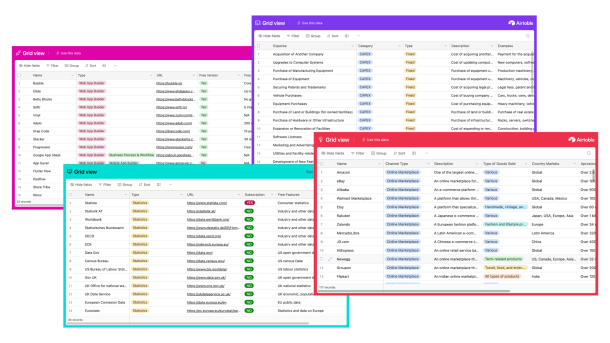Sales Strategy Guide
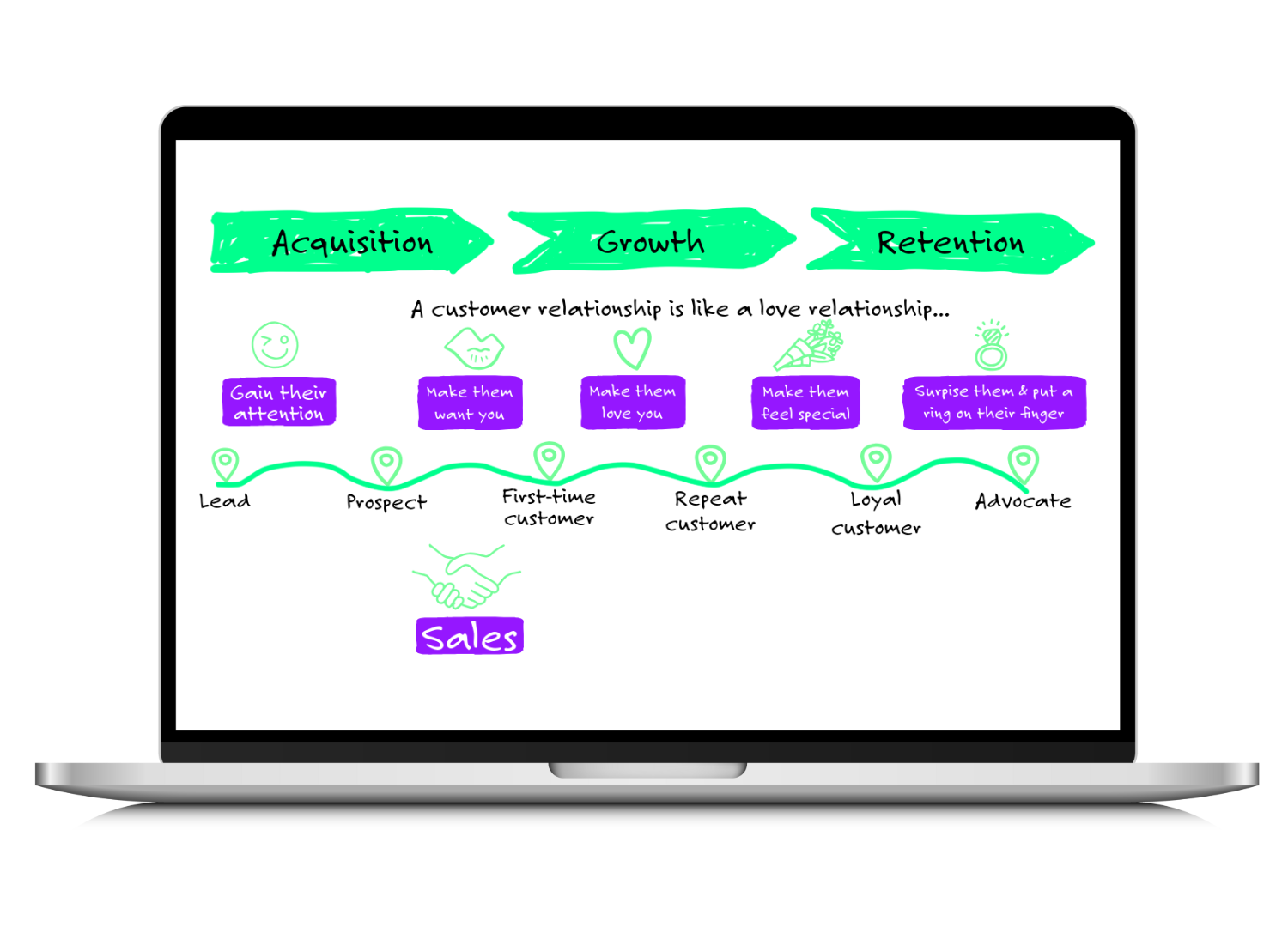
What is a Sales Strategy?
Your sales and marketing strategies are very closely related. While marketing focuses on generating and nurturing a pipeline of potential customers, sales is more focused on the direct interaction with the customer and the sales team and the process of closing deals with individual customers,
Depending on the type of product or service you are offering, sales activities that include the direct interaction with individual customers, become more or less important. Generally speaking the more complex your product the more focus and resources you will have to put into your sales activities. For example businesses that sell SaaS, consulting services or insurance will need to spend more time on explaining their product and convincing individual clients than businesses that sell clothes via an online shop or food supplements via amazon. The latter will probably put more resources into creating awareness and educating their audience through marketing activities.
Traditionally when you hear the word sales, you probably think of the nice shop clerk at your favorite retail store trying to convince you to buy that overpriced day cream that makes you look 10 years younger or the sales people traveling the whole country in their VW passat visiting client after client to “close the deal”. However, in this toolkit we will rather focus on more modern, mostly digital sales approaches suitable for new businesses in the digital age.
Note: 🍋 Throughout this guide we will use the example of a food supplement company to better illustrate each task and information.
What is a Sales Strategy Good For?
In today’s dynamic business landscape, a well-defined sales strategy is indispensable for all types of businesses, serving as a roadmap for customer interactions that drives revenue growth and cultivates enduring client relationships.
- Enhanced Customer Engagement: A well-defined sales strategy enables businesses to deeply engage with customers at every touchpoint, fostering meaningful interactions that build trust and loyalty over time.
- Streamlined Sales Process: It allows businesses to optimize and streamline their sales processes, eliminating inefficiencies and redundancies to ensure a smoother and more efficient journey from lead generation to conversion.
- Increased Revenue Generation: By implementing a structured approach to sales, businesses can maximize revenue generation opportunities, capitalize on cross-selling and upselling opportunities, and drive sustainable growth over the long term.
- Improved Customer Retention: A robust sales strategy focuses not only on acquiring new customers but also on nurturing existing relationships, leading to higher customer satisfaction, loyalty, and retention rates.
- Data-Driven Decision Making: Utilizing data analytics and insights, a well-defined sales strategy empowers businesses to make informed decisions, identify trends, and adapt strategies in real-time, driving continuous improvement and agility in the marketplace.
Curated Lists 📋
💡 To save you some time, we have prepared a free list with Sales Execution Tools that will be helful for implementing your sales strategy.
How to Define Your Sales Strategy Step-by-Step:
Step A: Sales Templates
Step B: Buyer Analysis and Goal Setting
Step C: Define your Sales Flow and Strategy
Step D: Identify Leads
Step E: Prepare your Cold Outreach
Step F: Prepare the Sales Meeting & Product/Service Presentation
Step G: Create your CRM & Metrics
Step A
Sales Templates
To work on your sales strategy you can either build your own whiteboard template for example on Miro, use Google Slides to build your product/service presentation and use Google Sheets to create your sales CRM or you can use our ready-to-use templates along with this guide.
Included Templates:
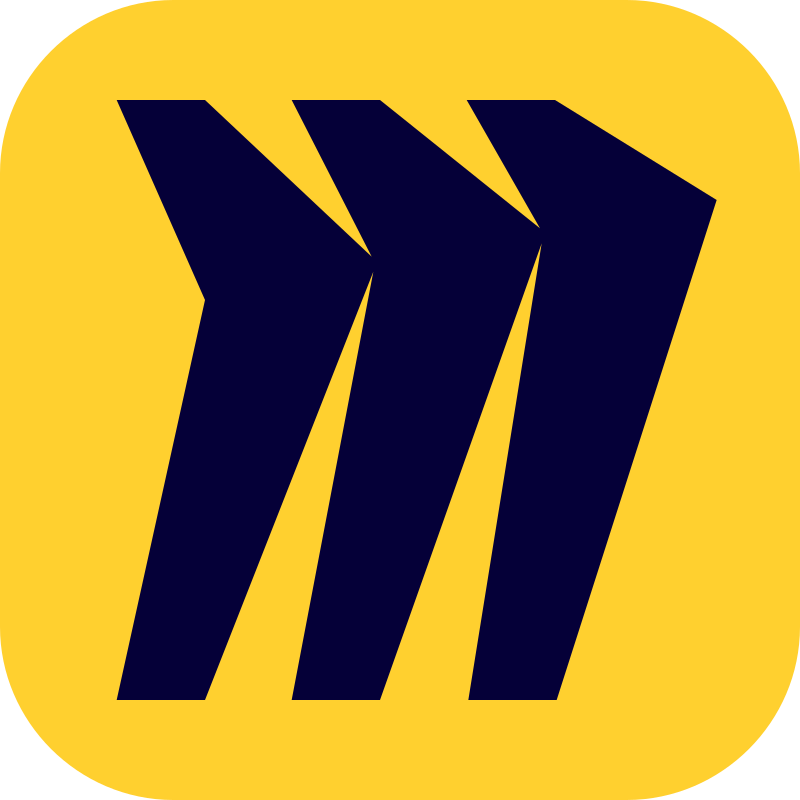
Sales Strategy Miro Board
Product/Service Presentation Template
Sales CRM Spreadsheet Template
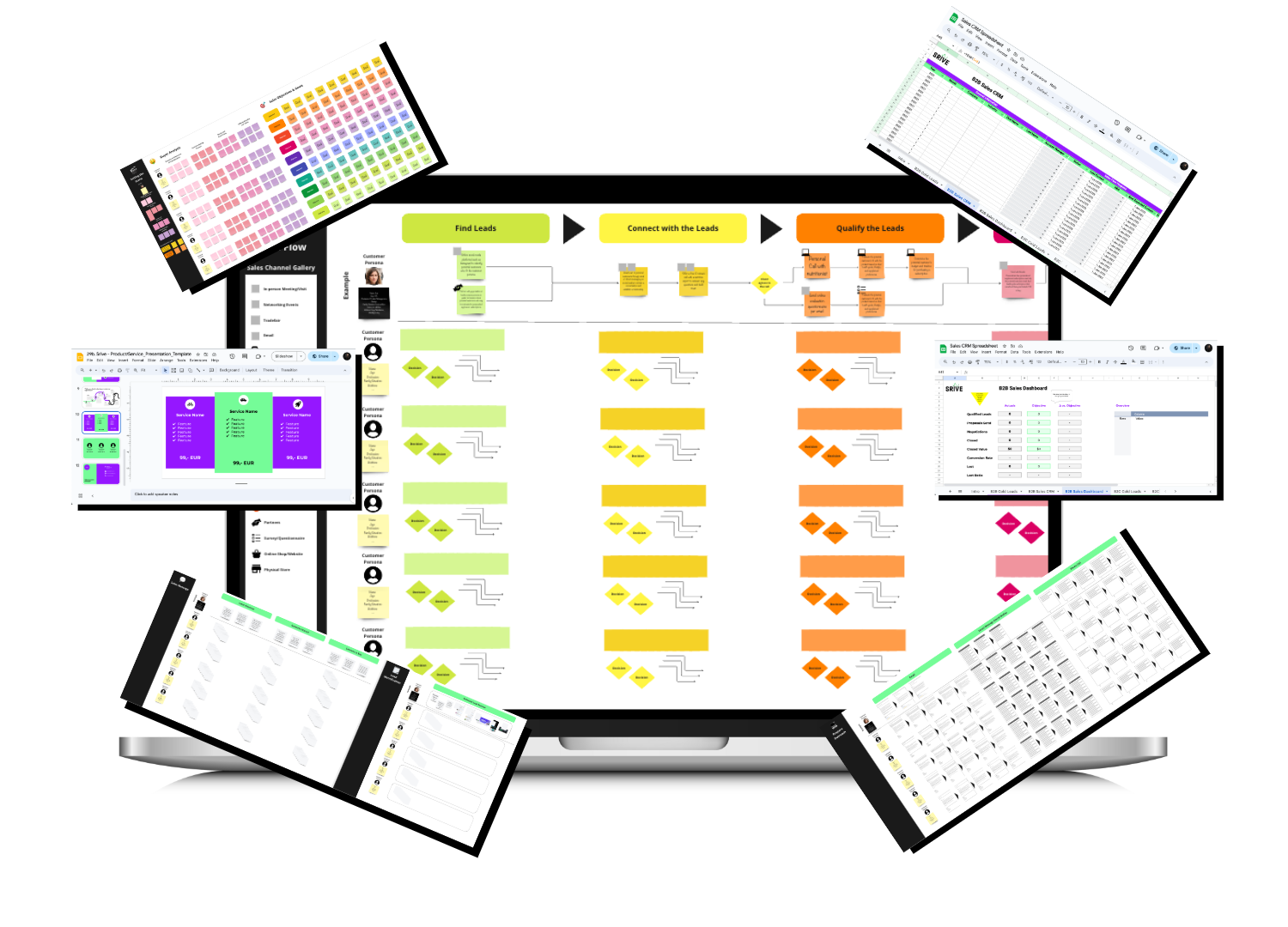
Step B
Buyer Analysis and Goal Setting

Before we define your sales strategy, we will start by setting the scene, just as we did for your marketing plan. We will again look at your customer personas and sales objectives.
Identifying and understanding your customers, or more specifically, buyer personas – meaning those people you want to sell to – is essential to create an effective sales strategy.
✅ So the first thing you should do is go to your Sales Strategy 📒Template and list your customer personas, each representing one of your customer segments, with a short description. Then, put yourself into the shoes of each persona and try to answer the following questions below, noting down your answers on the post-its in the respective area.
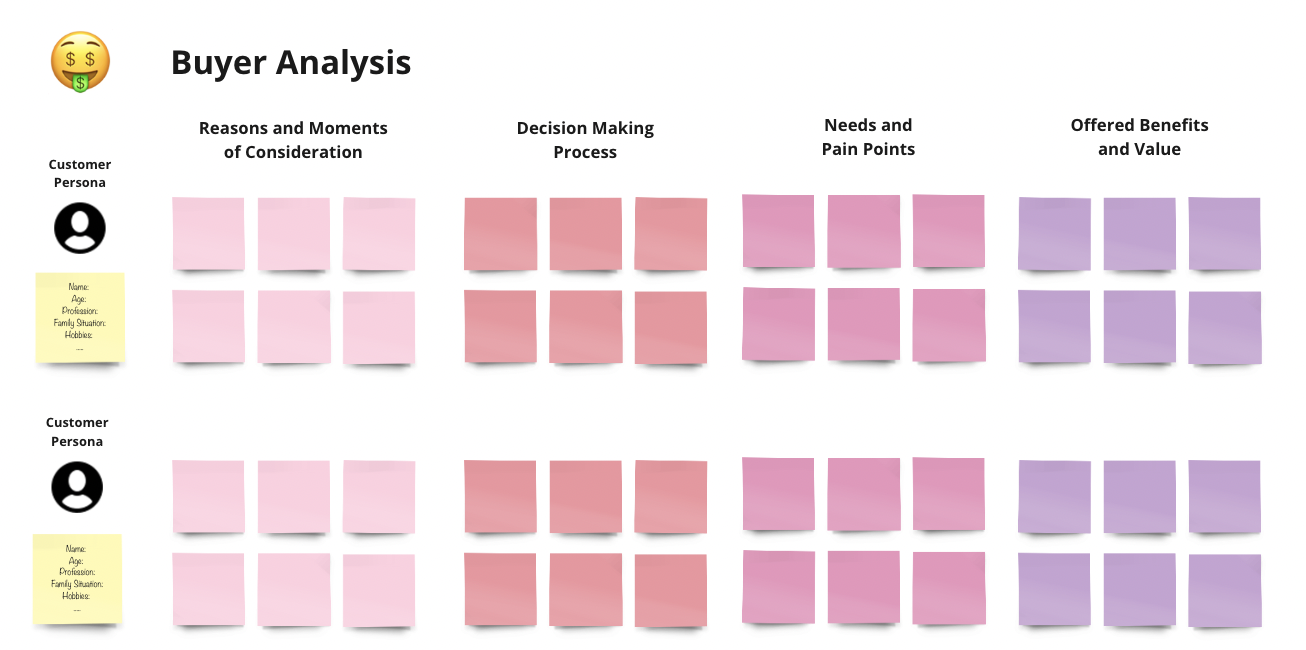
- Reasons and Moments of Consideration: What reasons or moments trigger the idea of purchasing a product or service like yours. For example:
- A new startup probably thinks about purchasing new SaaS when it just received funding.
- A person might start thinking about purchasing Vitamin D in autumn when there is less daylight and it gets colder.
- Decision Making Process: How does this customer persona make a purchasing decision? What criteria do they consider to evaluate options? Who else has an impact on the decision? What objections do they may have? For example:
- A Startup head of sales looking for a new CRM probably takes into consideration the opinion of the tech team and price is an important criteria because money is tight.
- A person looking for a good collagen serum probably asks a friend for their opinion and looks at criteria such as the price but also quality certificates.
- Needs and Pain Points: What needs or paint points does this customer persona have that we can help to solve? This knowledge can be essential for approaching a lead with the right messaging.
- A startup looking for a CRM SaaS probably struggles with keeping their customer spreadsheet clean and updated and that it is too complex for some team members to manage.
- Someone thinking of buying a food supplement probably feels low energy and weak in winter.
- Offered Benefits and Value: Which of the offered benefits or features does each customer persona value most?
- One startup might value a CRM that is as lean and easy to handle as possible while another is looking for the most comprehensive CRM with all extra features.
- When looking for a food supplement one person might value a low price while the other the fact that only vegan ingredients are used.
✅ Next note down your sales objectives and specific goals under each of those objectives. They are probably similar to your marketing objectives and should of course be aligned with them. However, the goals should be specific to your sales activities.
Possible objectives could be:
|
Sales Objectives |
Description |
Specific Sales Goals Examples |
|
Revenue growth |
Increase overall revenue and sales volume |
|
|
Market share growth |
Increase the percentage of the market that your business serves |
|
|
Lead generation |
Generate new leads for your sales pipeline |
|
|
Customer acquisition |
Attract new customers to your business |
|
|
Customer retention |
Keep existing customers and increase their lifetime value |
|
Go ahead and define your sales objectives and goals using the next area of your Sales Strategy 📒Template. Keep in mind that the goals you set should be SMART (Specific, Measurable, Achievable, Relevant, and Time-bound.)

Step C
Define your Sales Flow and Strategy

Now that you have analyzed your customer personas and specified your goals we can delve into defining your sales flow and strategy.
We will define your sales flow and strategy along the so called sales cycles, meaning the stages you pass your potential customer through, from the initial contact to the final decision to purchase your product or service.
At each stage a specific set of skills and sales activities are required to move prospects through each stage effectively. By understanding the sales cycle, you can tailor their approach to the needs and interests of each prospect and increase the chances of closing the sale.
The sales cycle typically includes the following stages:
- Find Leads: This is the prospecting stage, which involves understanding where you can find potential customers, identifying your potential customers and gathering information about them.
- Connect with the Leads: This stage typically involves reaching out to the potential customers through various channels such as email, phone, or social media, to initiate a conversation and establish a relationship.
- Qualify the Leads: This is the qualification stage, which involves evaluating the potential customer’s fit with the product or service, based on their budget, authority, need, and timeline.
- Present/Pitch Offer: This is the needs analysis and presentation stage, where the salesperson presents the product or service and demonstrates how it can solve the potential customer’s problems.
- Handle Objections: This stage involves addressing any objections or concerns the potential customer may have about the product or service.
- Close Sale: This is the closing stage, where the salesperson asks for the sale and gets the potential customer to make a final decision.
- Nurture: This stage involves maintaining communication with the customer after the sale to ensure satisfaction, resolve any issues, and explore opportunities for additional sales or referrals.
✅ Now, based on those stages try to lay out your sales flow. The sales flow is a step-by-step process that outlines the various stages of the sales interaction between your sales team and a potential customer. It is a visual representation of the journey a customer takes from initial contact with your business to closing the sale.
Brainstorm and define the sales activities and tactics that you could use to move your potential customers through your sales cycle. The activities at each stage may also differ for the various customer personas or not. Based on your each customer persona profile try to identify the most effective activities at each stage.

Use the second area of your Sales Strategy 📒Template to lay out the sales flow for your potential customer personas.
- Use the post-its to describe the step or sales activity
- Use the diamond to indicate points of decision
- Use the arrows to demonstrate the flow and how steps and points of decision connect with each other
- Use the icons to indicate the sales channel that you will use to interact with your potential customers at each step, just copy them from the sales channel gallery.
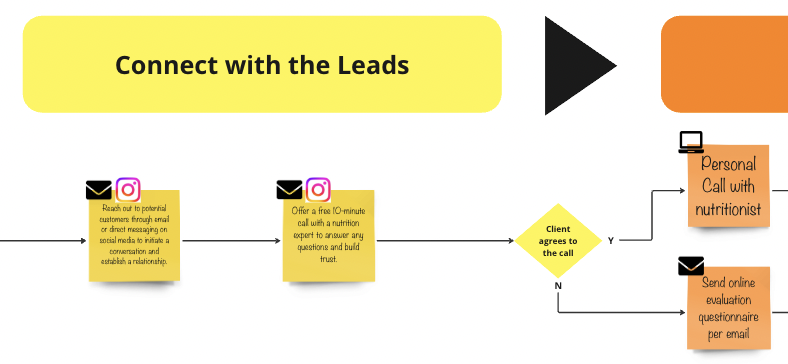
✅ Finally determine the sales messages for each customer persona. Your sales message is a concise and targeted message that conveys a specific point about your product or service and that aims to persuade the customer to take a specific action, such as making a purchase or booking a consultation.
A good sales message is crafted to speak directly to the customer’s needs and pain points, and highlights the unique benefits and value that your business can offer.
So for each customer persona you want to identify the specific “hook”, the key points to make him take the actions you defined.
The message is delivered through the channels you defined in your sales flow, and depending on the channel the phrasing of your message might change but the key points stay the same.
So go ahead and use the third area of your Sales Strategy 📒Template to define the sales messages for each of your customer personas in order to:
- Catch their attention
- Generate interest
- Convince them to buy
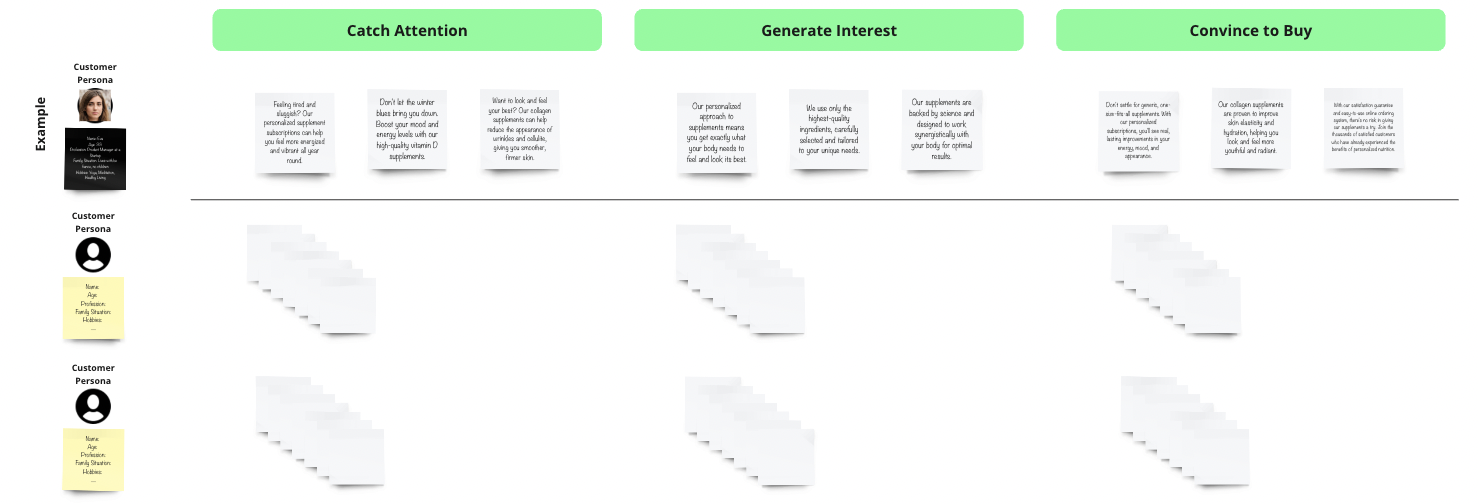
Keep in mind their needs and pain points as well as the benefits and value they probably seek most from your product when defining the messages. Also here are some best practices that you might want to consider when defining your sales messages.
- Personalize the message and show empathy by addressing their problems and needs.
- Clearly explain how your product or service solves a problem or meets a need that your potential customers have.
- Emphasize the potential negative consequences of not addressing the problem. This can create a sense of urgency and motivate the customer to take action.
- Focus on benefits, not features: Customers want to know how your product or service will benefit them, so focus on highlighting the benefits, rather than just listing the feature
- Personalize the message for different customer segments and highlight those parts of your value proposition segment values most.
- Emphasize the unique selling proposition (USP) of your product or service and how it differs from competitors.
- Create a sense of urgency for example through using limited offers.
- Create a sense of scarcity or make them feel special for example through inviting them to a “closed “
- Use social proof to show to resolve doubts and show that other had a good experience as well
- Address any objections or concerns that the customer may have before they even arise
- Ask provocative questions, by asking a question that challenges the customer’s assumptions or beliefs, you can pique their interest and engage them in a conversation
- Use language that resonates with the customer and reflects their perspective on the problem. This can help build trust and rapport with the customer, and make them more receptive to your message.
- Offer incentives such as free trials or samples, this can be an effective way to generate interest and convince potential customers to try your product or service. It can help alleviate any concerns or doubts the customer may have.
Now that you’ve laid out your sales strategy, we will take a deeper look into the topics of lead identification and cold outreach, sales meetings and products presentations as well as sales partners and cross selling. If you will use any of those sales tactics of course depends on the type of products and services you are selling.
💡 Before jumping into work, check out the Sales Execution Tools List above, with useful tools to execute your sales strategy
Step D
Identify Leads

There are a number of ways you can find potential leads and reach out to them. We will focus on those we find most suitable for new businesses in the digital age and give you some inspiration of how to approach these tasks.
First let’s talk about finding potential clients and creating a list of leads you can reach out to. Identifying leads is usually a little easier when it comes to B2B clients compared to finding B2C leads, simply because you will find more public information on business contacts than on consumer contacts.
The analysis you did earlier on your customer personas and about their reasons and moments of consideration as well as their decision making process will be very useful at this point since the results will give you ideas on where to look for leads.
For example, remember we said that potential leads for a SaaS company could be startups that just received funding and have money to spend → so where could you find startups that just received funding? → For example by looking at the portfolios of early stage VC firms like for example YCombinator
Or imagine you are a company selling food supplements and are looking for health conscious women to buy them → Where could you find them online? → For example by searching facebook groups on healthy living or recipes and checking their members.
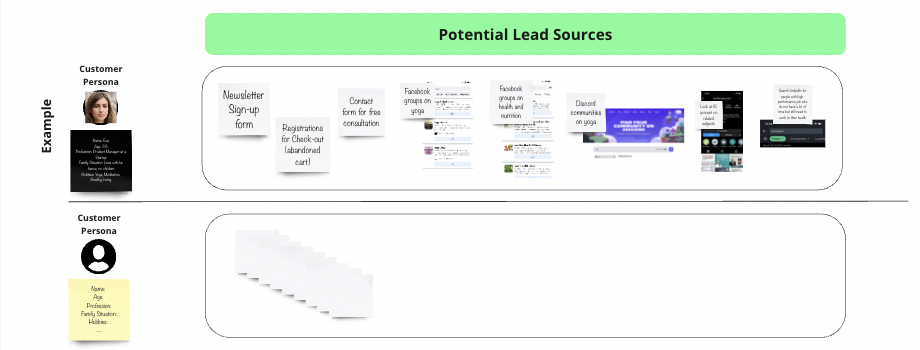
✅ Start with brainstorming and noting down potential sources and approaches to find leads for your different target customer segment. Use the fourth part of your Sales Strategy 📒Template to collect sources and plan your lead research. To find leads you can:
- Provide sign-up and contact forms on your website and social media and let the leads come to you. This tactic probably overlaps with your marketing activities, but it’s worth mentioning it again. Don’t forget to include contact forms and newsletter sign-up forms on your website and social media channels to capture the contact data of potential customers.
- Use company databases, directories, or portfolios to scan them for potential B2B target clients. You can find a number of platforms that you can use to find company information on your Sales Execution Stack 📋List.
- Search online communities and groups (e.g. Reddit channels, Facebook groups, Discord communities, etc.) on topics that are related to your product or service niche or to your target customers’ interests, hobbies, and so on.
- Attend physical or virtual networking events and connect with other attendees. Often the organizers even share an attendee list prior to or after the event so attendees can get in touch with each other.
- Use social media platforms like LinkedIn, Facebook, Twitter, and Instagram to search for individual leads and screen their profile. Some platforms like LinkedIn even offer search tools to find potential customers based on their industry, job title, location, interests, etc. Also, you can create awareness by using the comment function and commenting on posts of potential leads.
- Use lead generation tools to find leads. There are many tools available that can help you find potential customers, such as lead databases, email finders, and web scrapers. You will find some of those tools on your Sales Execution Stack 📋List. However, be sure to research the tools thoroughly before using them to ensure that they are legitimate and comply with anti-spam laws.
Once you have listed all your lead sources, get to work and start identifying potential leads and put together an initial lead list by adding your leads to your Sales CRM Spreadsheet 📒Template.
Start by going to the tab “Intro” and list all the leads sources that you are using (e.g. Crunchbase, LinkedIn, Newsletter sign-up etc.)

Then go to the tab B2C Cold Leads or B2B Cold Leads, depending if you focus on B2C or B2B customers. Then start adding your leads (one lead per line) by filling in the information in the corresponding cells. Fill in all the information that you can find and just leave the other fields blank, you can always add new information later.
You can of course adapt the fields (change, add or delete fields) and add segmentation variables (e.g. gender, age etc.) as needed.

This is of course not a one off task but a continuous process. Keep your lead list updated and add new leads over time. You probably also find new lead sources over time, so keep evolving and optimizing it.
Step E
Prepare your Cold Outreach

✅ Once you put together an initial list of leads start preparing your cold outreach to contact your leads.
Cold outreach refers to the act of contacting potential customers who you do not have an existing relationship with, usually via email, social media or phone, in order to generate awareness and probably first interest for your business, product or service, and usually with the objective to make them take a certain action.
Through which channels you contact them depends on your preferences but also on contact data you have available, for example you may not have the email address but the Linked-in profile of a potential lead. Basically there are three main ways to reach out to your leads (of course you could also go around and ring your leads’ doorbells, but we believe this is not really a contemporary approach anymore 😀):
- Social DM (Linked-in, Facebook, Instagram etc.)
- Cold-Call
To make sure not to burn any leads avoid randomly writing or calling leads without a thorough plan. Start by drafting your emails and direct messages templates or call scripts considering the sales messages you defined earlier for each of your target customer segments.
Here are some best practices that should help you to draft templates and scripts that convert better.
Email:
Drafting a great cold outreach email that converts isn’t that easy, we put together a list of best practices that should help you draft great sales emails:
- Use plain text emails. Other than your marketing newsletter that is usually nicely designed with beautiful images and formatting, you want your sales email to look as personal as possible like a simple email written by an individual.
- Adjust the key message based on the sales messages you defined for each target customer segment.
- (Carefully) use email marketing tools to send out your outreach mails to a list of recipients. Email marketing tools are great because they allow you to send out personalized emails not only to one but to a full list of recipients with just a few clicks and therefore save you a lot of time. You can find a number of email marketing tools on your Sales Execution Stack 📋List. However, emails that are sent using email marketing tools also often end up automatically in the spam folder so you want to use them with care. To reduce the risk of ending up in the spam folder you can:
-
- Warm up your email, increase the number of emails send per day little by little
- Set a daily sending limit, most email providers recommend to not send our more than 50-100 mails per day
- Use email authentication protocols such as SPF, DKIM, and DMARC to verify your email domain and help ensure that your emails are not flagged as spam.
- Avoid including lots of images or attachments
-
- Draft follow up emails to send out in case you don’t get a response, but don’t be pushy. Generally, one or two follow-up emails are appropriate for most situations. However, there are situations where sending additional follow-up emails may be appropriate, such as when you receive a positive response but the recipient hasn’t taken action yet.
- Focus on your opening line. Most email inboxes offer a subject line and email preview with a limited number of characters. So keep the length of your subject line and first sentence of your email short and to the point, so they can be fully displayed in the preview and catch the recipient’s attention.
- Search for inspiration in your own inbox. I’m sure you also received some sales emails in the past. Which of these emails did you open? What aspect was that which led you to open it or even react to the mail? Use those aspects as an inspiration to draft your own.
- Consider the rule of three, a principle in writing that suggests that things that come in threes are more satisfying, effective, and memorable than other numbers of things. When drafting your writing sales emails you could apply for example:
-
-
- Use three bullet points to highlight the key benefits of your product or service.
- Use a three-part email structure, with an attention-grabbing subject line, a personalized introduction, and a clear call-to-action.
- Break up long paragraphs into three shorter ones to make the email easier to read.
-
- Personalize your emails, even if you are using email marketing tools you can still personalize your emails to individual customers. Email marketing tools allow you to include personalized variables like your lead’s name, the company name and so on.
- Keep it short and to the point, most people are busy and don’t have time to read long emails. Keep your email short and focused on a specific topic or goal.A good rule of thumb is to aim for no more than 150-200 words in your sales emails. This allows you to convey your message clearly and concisely without overwhelming the recipient with too much information.
- The right timing matters. The timing of when you send out an email can have an impact on its effectiveness. The best time to send an email can vary depending on several factors, including your target audience, the purpose of the email, and the content of the message. But in general we could say: weekdays are generally better, midweek is the sweet spot, avoid early mornings and late evenings and consider the time zone of your target audience
- A/B test and optimize. Experiment with different subject lines, email templates, and sending times to see what works best for your audience, and continually optimize your approach based on the results.
⚠️ATTENTION!!!!! ⚠️
Depending on which country you are in you will have to take into account local regulations regarding contacting leads especially via email for sales or marketing purposes. Just make sure to check and understand the local regulations regarding data protection and anti-spam for the markets you are operating in. For example, in the US the CAN-SPAM act applies, while in Europe you need to consider the GDPR. ePrivacy Directive.
Now go ahead and use the Sales Strategy 📒Template to draft your cold outreach emails including the follow-up messages for the different target customers.
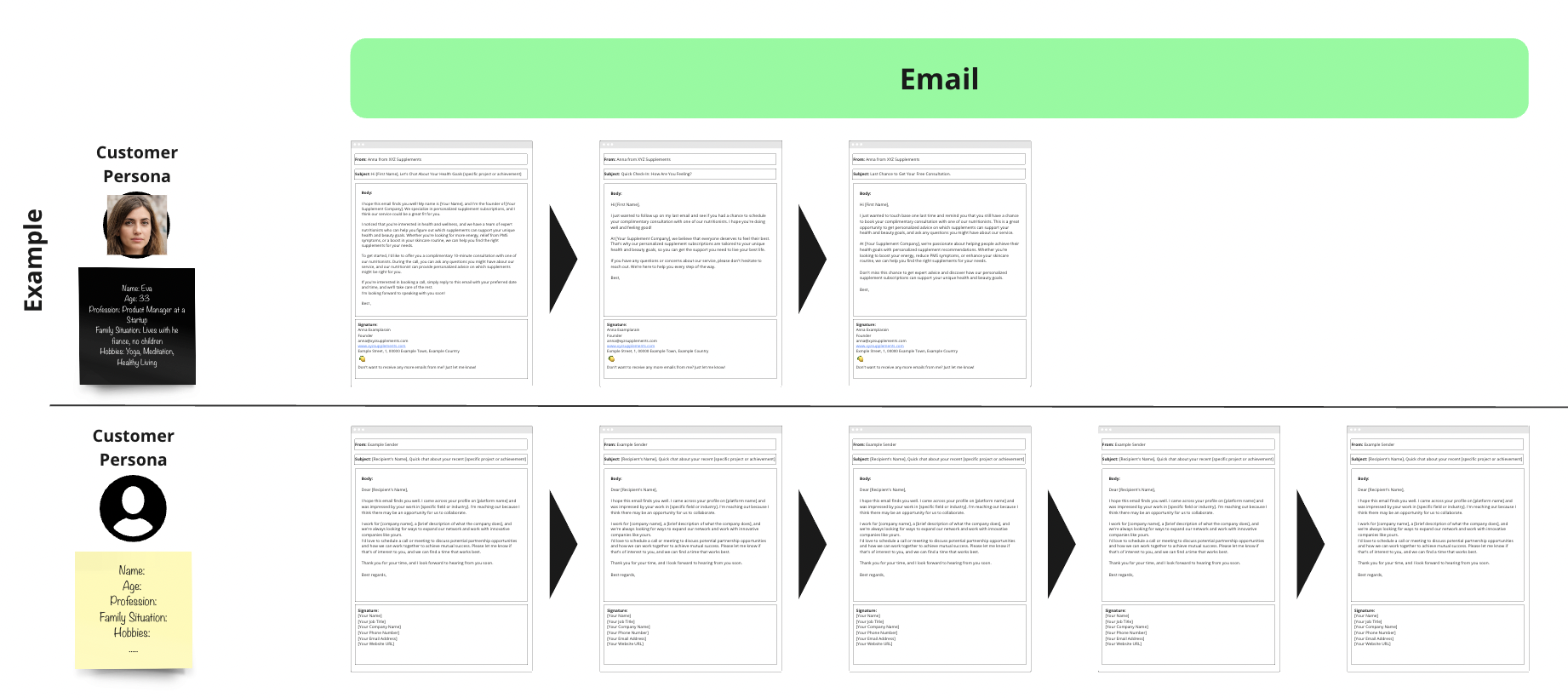
Social Media Outreach:
Another way to contact your leads is through social media channels using direct messaging or even comment functions. LinkedIn for example is a platform commonly used for sales outreach. However, most of these platforms block your messages from landing directly in your leads DMs if you are not on their contact list. To avoid this you either need to request them to connect with you first or in the case of LinkedIn, use their paid InMail Service.
Just as for your email outreach, your cold messages also should be carefully drafted taking into account the sales “hooks” you defined for the individual target customer segments. You may also want to consider the following best practices:
- Keep your message short and focused and avoid sending long messages that are difficult to read. A direct message should be even shorter than an email so really try to be concise and focus on the key messages.
- Start with a friendly and casual greeting that addresses the recipient by name. Avoid using generic or overly formal greetings, as this can make your message seem impersonal.
- Be clear about who you are and what your company does. Provide a brief introduction that explains your value proposition and how you can help the recipient.
- If you have any mutual connections or interests, mention them in your message. This can help establish a common ground and make the recipient more likely to engage with you.
- Be specific about why you are reaching out. Explain why you are reaching out and what you hope to achieve from the conversation. Be clear and concise in your messaging and avoid being vague or unclear.
- Focus on providing value to the recipient keeping in their potential needs, problems and seeked benefits. Offer them something that will help them solve a problem or achieve their goals. This could be in the form of a resource, advice, or a service that you provide.
- End with a question or call-to-action: End your message with a question or call-to-action that encourages the recipient to respond. This could be a question, a request for a meeting, or an invitation to learn more about your company.
- Follow up strategically. Remember that cold messaging is about starting a conversation and building a relationship. Be patient and don’t expect an immediate response and prepare follow up messages that focus on providing value to the customer.
Use again the Sales Strategy 📒Template to draft your cold message flow for the different target customers.
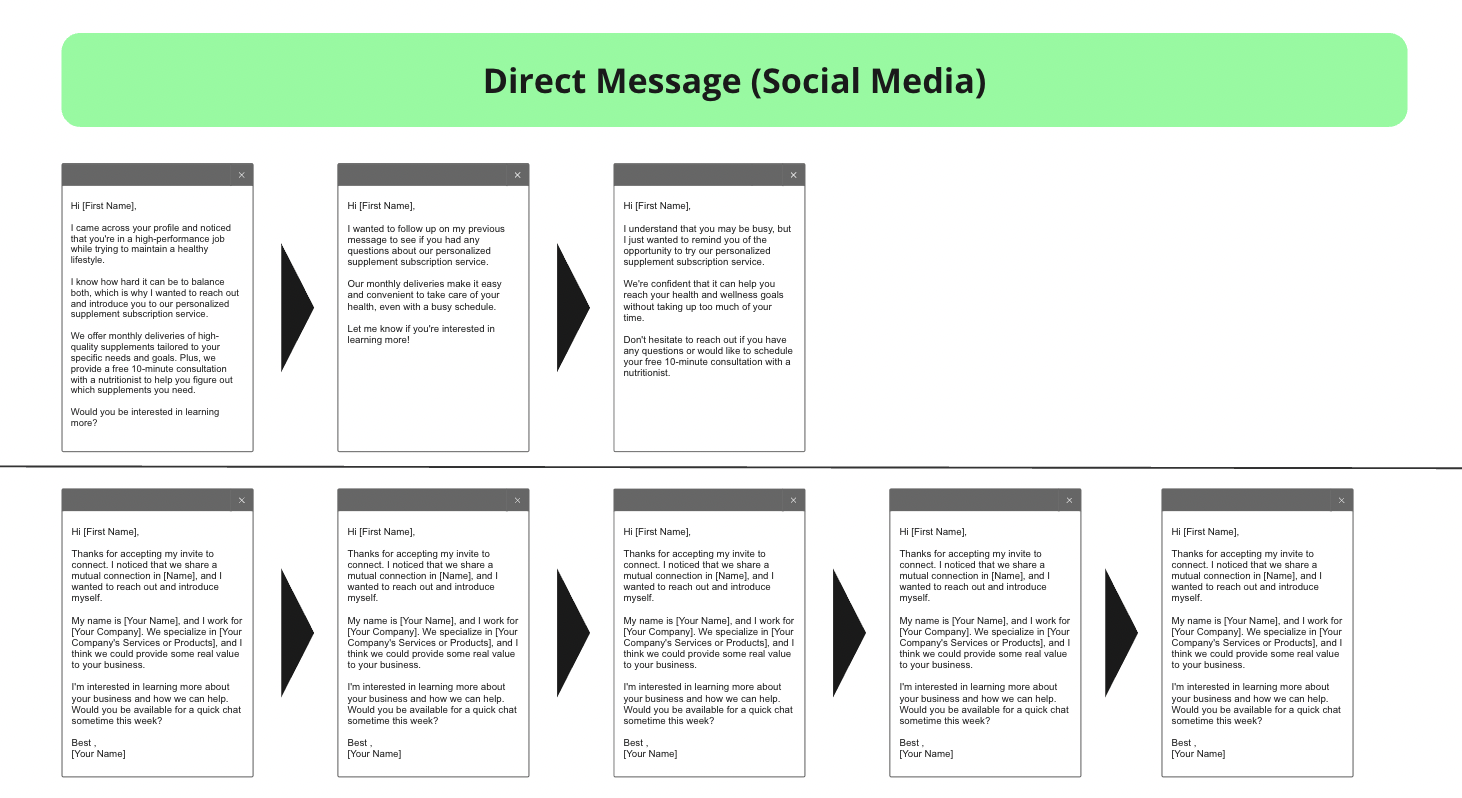
Cold Calls:
And finally there are cold calls, a more “traditional” and labor-intensive way of reaching out to your leads. But well it could be a suitable approach for cold outreach for example if you are targeting small local businesses or traditional companies.
For most people cold calling is not an easy task since it also requires a quite a high level of confidence and persuasion skills to close a call successfully. This is why in this case as well it is essential to plan a proper pitch and elaborate a sales script.
- Think about how to structure your call: A well-structured call can make a huge difference in its success. Start with a strong opening to grab the prospect’s attention, then move into an introduction that establishes your credibility and builds rapport. From there, ask thoughtful questions to learn more about the prospect’s needs and pain points, and tailor your pitch accordingly. Finally, close with a clear call-to-action that moves the conversation forward.
- Be very clear about the desired outcome: Define what you want to achieve during the call and structure your script in a way that leads the conversation towards that outcome. This will help you stay focused and guide the conversation towards a successful conclusion. Additionally, make sure to have a clear call-to-action at the end of the call, whether it’s setting up a follow-up meeting, scheduling a demo or closing a deal.
- Research your prospect: Before you make the call, research the prospect and their company so you can personalize your pitch and demonstrate that you understand their needs and pain points.
- Be confident and enthusiastic: Your tone of voice and energy can make a big difference in how the prospect responds to you. Be confident and enthusiastic about your product or service.
- Listen actively: Listen carefully to the prospect’s responses and objections, and be ready to adjust your pitch accordingly.
- Keep it conversational: Your script should sound natural and conversational, not like a robotic sales pitch. Practice delivering your message in a natural and engaging way.
- Focus on benefits, not features: Instead of listing the features of your product or service, focus on the benefits that your prospect will receive. Explain how your offering can help solve their specific problems or achieve their goals.
- Address objections: Anticipate common objections and prepare responses that address them in a positive and helpful way. This will help build trust and credibility with your prospect.
- Use open-ended questions: Ask open-ended questions to engage your prospect in a conversation and uncover their needs and pain points. This will help you tailor your message and pitch more effectively.
- Respect their time and don’t be annoying: Be respectful of the prospect’s time, and if they’re not interested, thank them for their time and move on to the next call.
- Practice, practice, practice: Practice your script until you feel confident and comfortable delivering it. Role-play with a colleague or mentor to get feedback and improve your delivery.
Use the Sales Strategy 📒Template to draft the sales script for your outreach calls. Try to outline the structure and clearly indicating the different parts of the call.
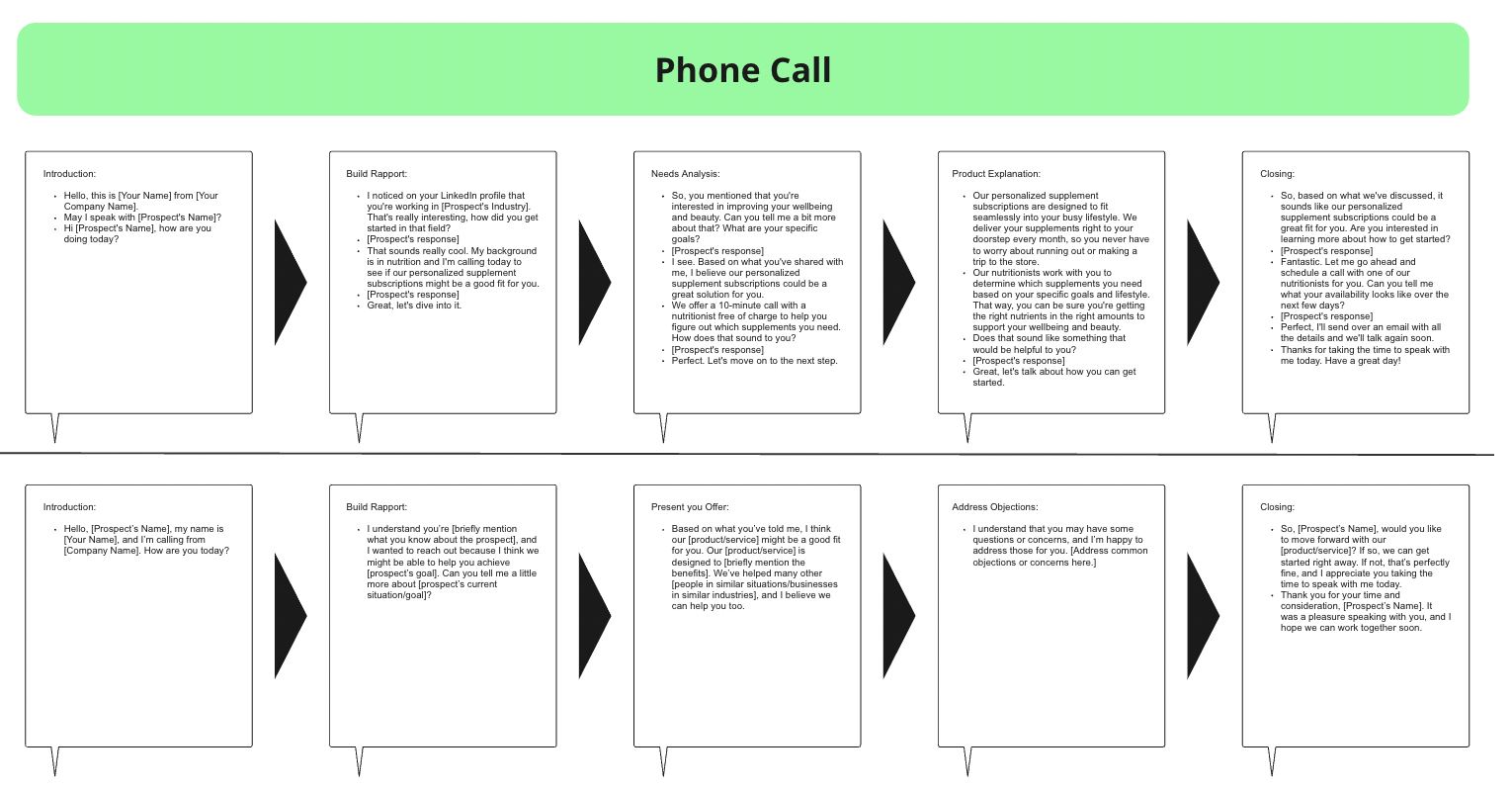
Step F
Prepare the Sales Meeting & Product/Service Presentation

Once you convince a lead to hop on a sales meeting, the next step is to plan the sales meeting and prepare your product or service presentation.
First of all, you should be clear about the desired outcome of the meeting and the structure of the meeting. A sales meeting could, for example, be structured as follows:
- Introduction: Start by introducing yourself and your company, and thank the client for taking the time to meet with you. Explain the purpose of the meeting and what you hope to achieve.
- Discovery: Ask questions to understand your prospect’s needs and pain points. Listen actively and take notes. This is also an opportunity to build rapport and establish trust.
- Value proposition: Present your solution and how it can address your prospect’s needs. Focus on the benefits and outcomes that the prospect can expect, rather than just the features of your product or service.
- Objections handling: Address any concerns or objections that the client may have. Be prepared to provide evidence and data to support your claims.
- Next steps: Summarize the main points of the meeting and confirm the client’s interest in moving forward. Agree on the next steps and timeline, such as a follow-up call, a proposal, or a demo.
- Closing: Thank the client again for their time and consideration. Reiterate your commitment to help them achieve their goals and provide value.
Also, before the meeting, make sure to do some research on the lead and their company. This will help you understand their pain points and tailor your pitch accordingly.
Finally, prepare the Product/Service Presentation 📒Template that you can use as a basis to build your own. Download the template.
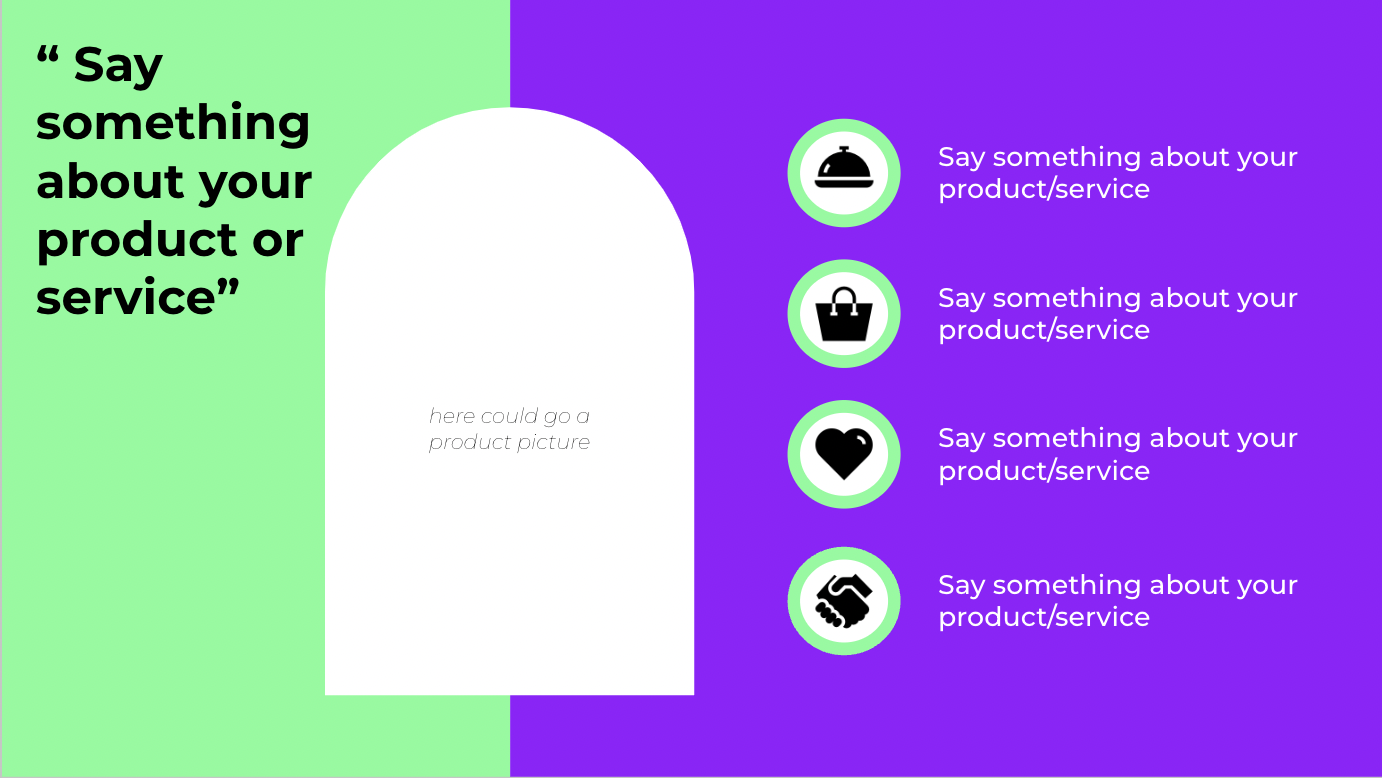
Step G
Create your CRM & Metrics

Finally you also want to keep track of your sales performance by setting up your Sales CRM, lead scoring system and sales metric analysis.
A sales CRM (Customer Relationship Management) is a tool that helps you to manage your customer relationships, sales pipeline, and sales processes. It is designed to help your sales team organize and track customer interactions, sales performance and streamline your sales processes.
There is a huge variety of CRM tools out there, a selection of which you will find on your Sales Execution Stack 📋List.
However, if you are just starting out, a Sales CRM spreadsheet can do the job. As your business grows, you might want to consider switching to a CRM software that brings more advanced functions to manage a larger number of potential customers and more complex sales processes. But initially, you can use our Sales CRM Spreadsheet 📒Template to keep track of your sales.
So, what are you waiting for? Go ahead and open the template.
You will find four types of tabs: Intro Cold leads (B2B/B2C) Sales CRM (B2B/B2C) Sales Dashboard (B2B/B2C)
So, first of all, if you focus on B2B clients, use the violet tabs. If you focus on B2C clients, use the green tabs.
✅ To get started take a look a the 🗃️ INTRO tab and fill in the variables (light green fields)

- Start by introducing your company name in the field at the top.
- Then add your lead sources, meaning the channel where you find your leads (e.g. Newsletter sign-ups, LinkedIn, Crunchbase, etc.)
- Then add the names of your sales team.
- Next, define the statuses and the corresponding descriptions to indicate in which stage of the sales lifecycle your customer is. We pre-defined some common statuses, which you can just leave as they are if you want. If you change the status names, don’t forget to adjust the formulas in the sales dashboard tab.
- Finally, define your Next Best Actions (NBA). Those are the actions that you perform if a potential customer passes to a certain stage of your sales lifecycle.
✅ Next, you have the 🗃️ COLD LEADS tab. Here, you can collect all the cold leads that you find during your research (if you haven’t already done so). Your cold leads are the leads that you have identified and intend to connect with during your cold outreach but have not yet contacted.
Add your leads by filling in the general information, contact information, social media information, and any other segmentation variables that you define. If you are missing any of the information, just leave the fields blank.

✅ Once you have contacted a lead, or at least scheduled the outreach you can move the lead to the 🗃️ SALES CRM tab. Besides the general and contact information you will find some new fields with information.

Sales Flow Progress Information:
- Account Manager: Assign this leads by selecting one of your sales team members from the drop down list.
- Status: Indicate their status by selecting the current status from the drop down list.
- Last Contact: Indicated the date of the last contact.
- NBA: Indicate what the Next Best Action is by selecting it from the drop down list.
- Next Expected Contact: Indicate when you expect to contact this potential customer again (e.g. when you plan to send a following up email or when you have scheduled a meeting)
- Estimated Deal Size/CLV: Take a guess and indicate the potential revenues you could be expecting from this potential client. For B2B client you could guess the deal size, for B2C customers the expected Customer Lifetime Value.
Lead Scoring:
Next take a look at the lead scoring information. A lead scoring system is a methodology used to rank and prioritize your potential customers or leads based on variables such as their interest, fit and potential value.
It is a way of assigning a numerical value or score to each lead based on certain criteria, to focus your sales and marketing efforts on the leads that are most likely to become customers.
To use the lead scoring system you will first of all have to define the criteria which impacts the score. If you go back to the 🗃️ INTRO tab and scroll down you will find a number of lead scoring variables.
Go ahead and assign the number of points you consider to each variable and level. The more points, the higher the score, the more important the lead.
- Lead Source: Is the potential client an inbound lead, meaning they proactively showed interest in your business e.g. through filling out a contact form or signing up for a newsletter. Or is there a lead you reached out to first? ➡️ Inbound leads may be more valuable since they actively showed interest.
- Level of Interest: How high would you estimate their interest? ➡️ The higher the interest the better.
- Target Customer Fit: How would you evaluate their fit with your target customer segments? Do they fit into the segmentation variables you defined? ➡️ The higher the fit the better.
- Expected Deal Size/CLV: How high do you expect the revenue to be that you gain from the customer? Introduce as well the numerical range of what you would consider as low, medium and high revenues. ➡️ The higher the Expected Deal Size/CLV the better.
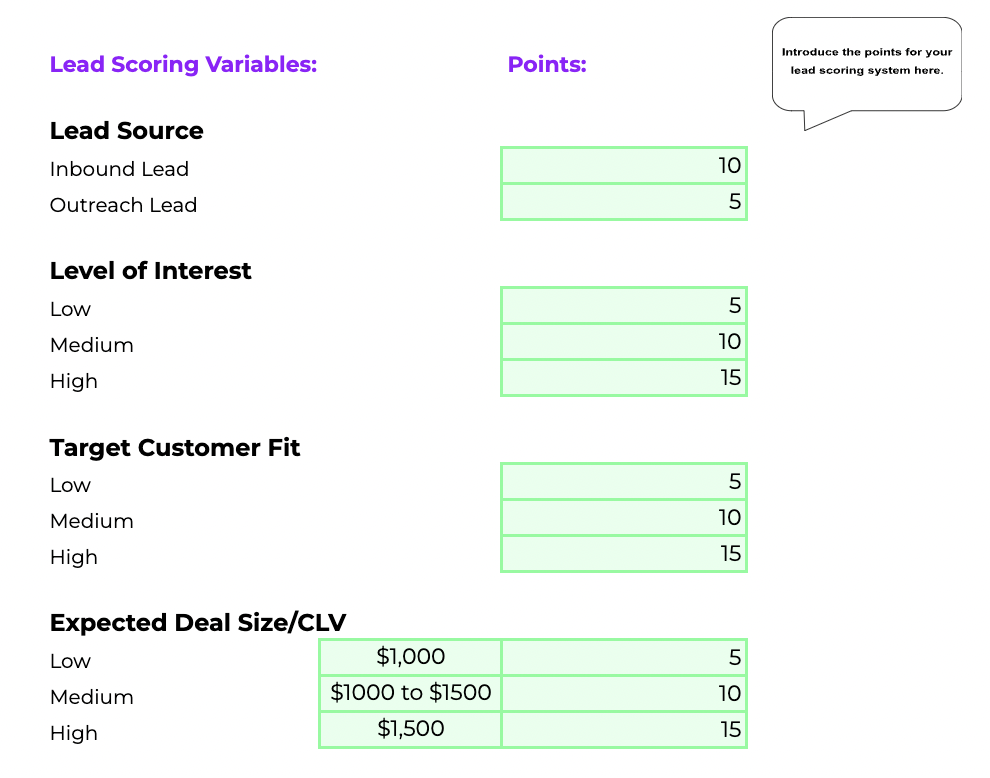
Once you define the number of points for each variable and level. You can now go back to your 🗃️ SALES CRM tab and indicate for each potential client you add the indicated levels (the Level of Deal Size/CLV will be calculated automatically based on the value you introduce in the field Expected Deal Size/CLV ).
The lead score is then automatically calculated based on those variables and you can use this score to prioritize your leads.
✅ And finally you have the Sales Dashboard, to track your sales performance metrics. You will find it under the 🗃️ SALES DASHBOARD tab. Here you can automatically compare your actual performance metrics against the objectives you set. All you need to do here is to introduce the objectives you set for each metric, the actual number and the difference will be calculated automatically.
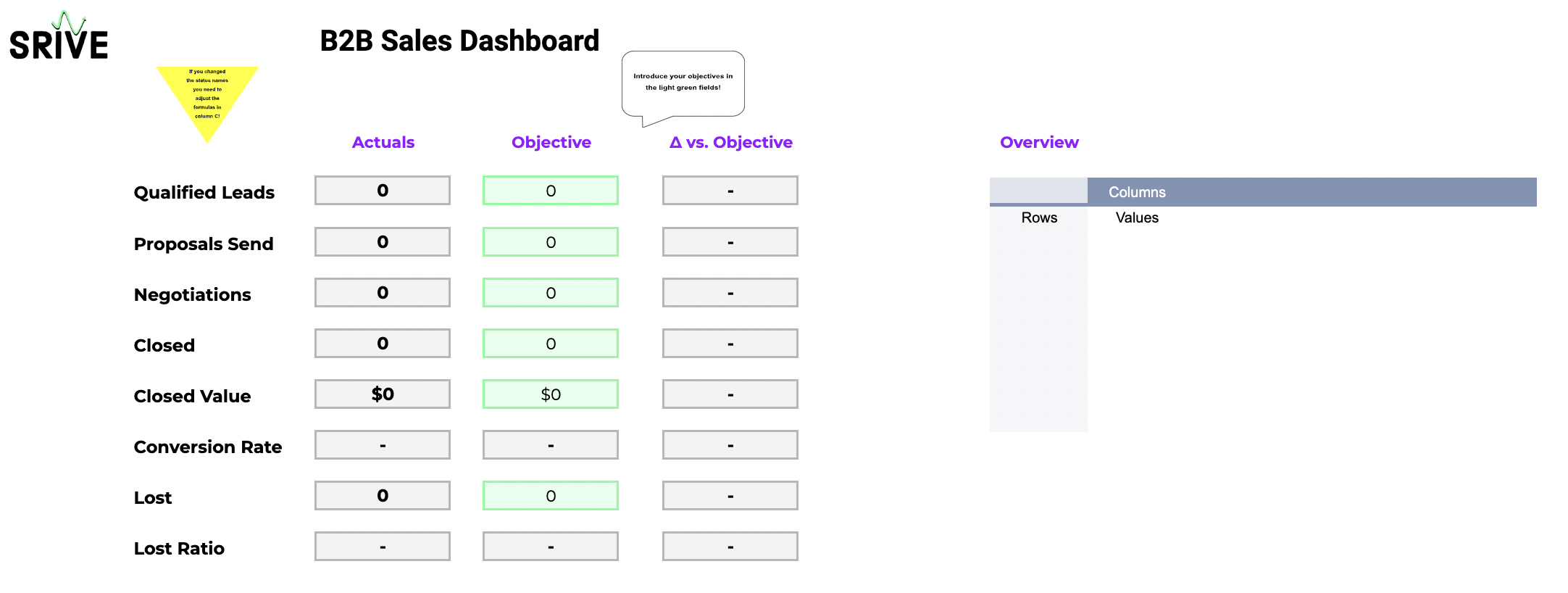
- Qualified Leads: Define how many qualified leads you plan to generate in a given period?
- Proposals Send: Define how many of those leads will you objectively be able to present your product/service to?
- Negotiations: Define with how many of your leads you will get to the stage of negotiating or resolving objections?
- Closed: How many leads will you close and convert into customers?
- Closed Value: How much value (revenue) do you expect those closed customers to generate?
- Conversion Rate: The conversion rate meaning closed customers vs. leads is calculated automatically.
- Lost: How much of those leads do you expect to lose?
- Lost Ratio: The lost ratio meaning lost customers vs. leads is calculated automatically.
And with this you finish not only your sales strategy for customer acquisition but your go to market plan. Keep in mind that most of the tasks we worked during these last weeks are no one-offs, but tasks that you will have to keep executing continuously over time. Remember as well to keep testing, adjusting and optimize everything from your pricing and distribution channels to your marketing and sales activities.

